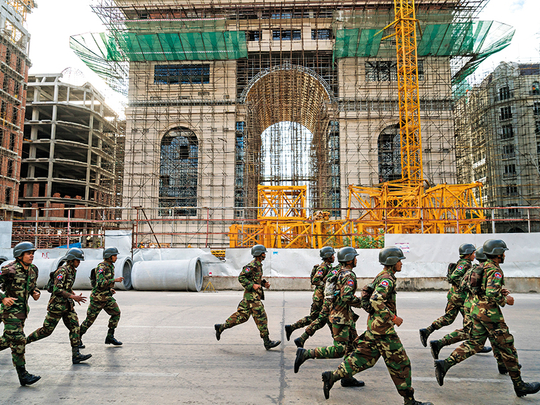
Phnom Penh: To sell real estate in Cambodia, agents are brushing up on their Mandarin.
Across the traditionally low-rise Cambodian capital, a building boom is becoming more noticeable as it pushes higher into the sky, and its largest projects are often geared toward Chinese investors, who have only recently taken interest in the nation’s real estate market.
Chinese investors are flocking to Phnom Penh, which had primarily been an investment destination for southeast Asians, Taiwanese, Japanese, South Koreans and some Westerners. For many of the capital’s largest projects, Chinese are now viewed as the target market.
“Historically, Chinese investment in Cambodia has mainly been in infrastructure,” Ross Wheble, the country manager for Cambodia for the real estate consultant Knight Frank, said. “It is only within the past 18 months that we have started to see the entry of Chinese developers and individual investors.”
This year is going to be a big one in terms of high-end residential property coming on line, Wheble said. In 2017, 3,488 high-end residential units were added to the existing supply in Phnom Penh, he said, adding, “We forecast an additional 15,688 units to complete in 2018.”
One of the largest companies vying for Chinese investors is the Prince Real Estate Group. In the city’s central district of Chamkar Mon, across the street from Cambodia’s National Assembly and the Australian Embassy, statues of Minions characters stand outside a showroom for Prince Real Estate. A large sign, in Chinese and Khmer, advertises luxury condominiums ranging from 23 to 175 square meters with an expected 12 per cent annual return on investment and monthly payment plans from $386 (Dh1,417).
Next to the embassy, a competitor’s almost-completed project called the Bridge — Cambodia’s tallest and largest residential development — looms large.
Chinese investors and affluent Cambodians
Prince Real Estate has multiple projects in Phnom Penh’s centre. Its 37-story Prince Central Plaza, with more than 1,000 condominium units, is scheduled for completion in May. The 27-storey twin-towers of Prince Modern Plaza are set to be finished one year later. It owns one completed project, Diamond 1, on Diamond Island, a 1-mile-long parcel of land adjacent to the city’s only casino that is buzzing with real estate projects aimed at Chinese investors and affluent Cambodians.
Outside the firm’s showroom, shuttle buses stand ready to transport prospective buyers to Prince Central Plaza, while sales agents fluent in Mandarin wait to show off model units, which sell for $2,600 a square meter on lower levels and up to $4,000 a square meter for penthouse units.
“In terms of purchasing, it’s basically all Chinese,” said Chen Jingjing, a sales agent, who noted that most buyers tended to come from Fujian and Zhejiang provinces, along with the cities of Shanghai and Shenzhen.
“Most people are buying for investment, but some will live in their flat because they have a company or do business here,” she said. Around 90 per cent of the units at Prince Central Plaza had already sold, she said, with around half the Chinese buyers paying cash.
Cambodia offers rapid economic growth, a young population and good returns on investment, but there are other reasons that the Phnom Penh property market appeals to Chinese investors, including China’s mounting debt. “Chinese businessmen are acutely aware that the country has a chronic debt problem, and it’s anyone’s guess in a place as opaque as China when that bubble will explode,” said GeorgeMcLeod, a political risk consultant based in Bangkok. “Businessmen with wealth in excess of a few million dollars are scrambling to squirrel cash outside of China’s borders and the reach of its unpredictable authorities.”
Anti-money laundering policies
Additionally, Cambodia is primarily a cash economy, with the US dollar accounting for the vast majority of money in circulation, which creates opportunities for money laundering.
“Cambodia’s banks have lax internal controls and policies around anti-money laundering and know-your-client compliance, making them wide open to serve as vehicles to launder cash from criminals and corrupt government officials,” McLeod said. “Given my experience doing investigations in Cambodia, I am convinced that laundered money from the PRC is a substantial portion of property investment in Phnom Penh.”
Another major selling point for Chinese buyers — one that features prominently in marketing materials for many real estate developments — is that Cambodia is a key participant in One Belt, One Road, an infrastructure initiative from President Xi Jinping of China that is harnessing hundreds of billions of dollars in state and private investment to bring Southeast Asia, Central Asia, Europe and other regions closer to China.
Cambodia’s prime minister, Hun Sen, has become one of China’s most reliable friends. Having used Vietnamese support and then Western aid to consolidate and preserve his rule over the last three decades, Hun Sen has moved on to become China’s strongest ally in Southeast Asia, an area where Beijing has extensive development plans.
In December, Chinese firms pledged to invest an additional $7 billion in Cambodia, including in a highway that will connect Phnom Penh with Sihanoukville, Cambodia’s main port. Sihanoukville is also a major destination for Chinese property investment and China’s Belt and Road ambitions.
Belt and Road initiative
The highway will reach from Sihanoukville on the Gulf of Thailand to Phnom Penh’s international airport. Unsurprisingly, the Sen Sok district surrounding the airport is attracting more Chinese residential development and investment.
Like Prince Real Estate’s developments, the Star City project in the Sen Sok district is also using the Belt and Road initiative to attract buyers. The nearly 400,000 square foot joint development by the Cambodian conglomerate Thai Boon Roong and China’s Xinghui Property is being built by a company from China’s Sichuan province. It will feature five condo buildings and a hotel, apartments and offices, with a total of 2,112 units for sale.
Star City’s location near Phnom Penh’s airport and the highway to Sihanoukville is made even more attractive by lower costs for condo and apartment buyers, the Star City deputy sales manager, Chhiv Vining, said. The Sen Sok district is an up-and-coming area with units starting at $1,600 a square metre.
Chhiv said that 80 per cent of Star City’s Tower A had been sold, and sales had just begun on Tower B, but were limited to studios and one-bedroom units. She estimated that Chinese investors accounted for 80 per cent of buyers so far.
“We’re looking to the Chinese market first,” she said.











